Online shoppers no longer settle for one-size-fits-all storefronts. Sorry to say it, but your default Shopify theme will soon give the ick…
In a world where Netflix predicts your next binge and Spotify curates playlists you didn’t know you needed, static product grids and generic category pages just don’t cut it anymore.
AI, AI, AI… we know, it’s everywhere. And yes, it’s starting to feel like the tech version of gluten-free. But when it comes to e-commerce, AI actually has substance, not just hype. It’s quietly transforming online shopping from browse and hope to discover and convert… and some retailers are getting left behind.
From real-time product recommendations and personalised category pages to predictive offers and intelligent search, AI is reshaping how brands connect with their customers, and how customers decide where to spend, even if they don’t realise it.
In this article, we break down:
- What AI in e-commerce actually means (beyond buzzwords)
- How brands are using it right now to increase revenue, relevance, and retention
- The best AI personalisation tools in 2025 (with real pros and cons)
- What’s coming next, and how to future-proof your store before your competitors steal your thunder.
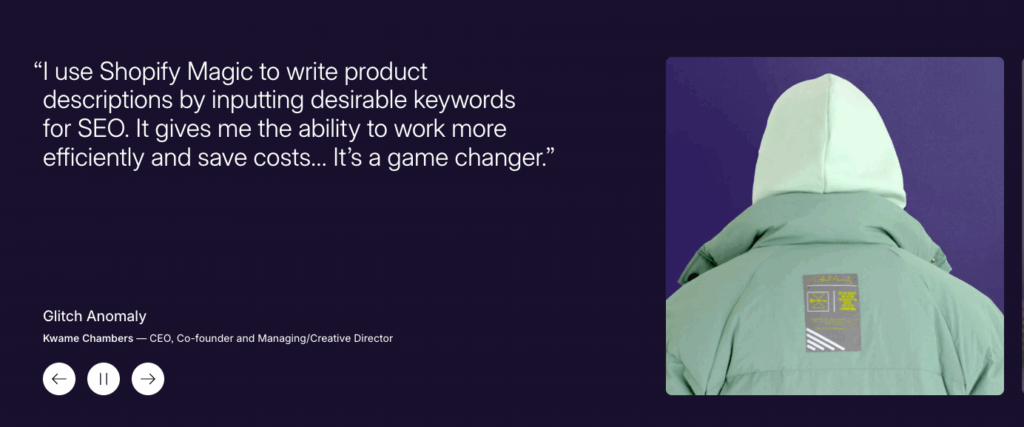
What is AI e-commerce?
AI e-commerce is the application of machine learning, natural-language processing, computer vision and predictive analytics to automate, personalise and optimise every stage of an online retail journey; search, merchandising, pricing, service, logistics and retention.
In plain English? It’s another tool to make your store better at selling to each customer.
It’s easy for the marketer to forget, but customers are humans. And humans are lazy, impatient and easily distracted.
So instead of showing the same generic content to everyone, AI helps you deliver real-time, one-to-one experiences. Product recommendations, search results, pop-ups, promotions – even pricing – can become more relevant, more intuitive, and far more likely to convert.
AI makes ecommerce feel less like a catalogue and more like a conversation. It notices what people browse, click, ignore, abandon, or buy and quietly reshapes the storefront around them.
Done right, it’s not about making things more robotic. It’s about making your store feel personal than ever before.
“Marketing is a service. Your customer is looking for something. As the marketer, it’s your job to make that thing as easy as possible to find. AI is just another tool to help you do that… at scale.”
So does it work, and what is the impact?
To get a clearer picture of just how much AI improves performance, we analysed aggregated case studies from platforms including Monetate, Nosto, Dynamic Yield, Adobe Commerce and Amazon Personalize, covering the period up to Q2 2025.
Here’s the average uplift retailers report after implementing AI personalisation:
| Metric | Average Lift After AI Adoption* |
|---|---|
| Conversion Rate | +15-40 % |
| Average Order Value | +10-30 % |
| Repeat Purchase Rate | 1.7× – 2.3× |
| Marketing Spend Efficiency | –20-30 % CPA |
Whether you’re a small D2C brand, B2B wholesaler or marketplace operator, AI can unlock measurable gains across your funnel, not in years, but in months.
Why the lift?
Reduced scrolling & overwhelming choice – AI surfaces the right product first.
Higher relevance – Content blocks, banners and search results shift to match real-time intent.
Customer loyalty – Shoppers feel understood, not spammed.
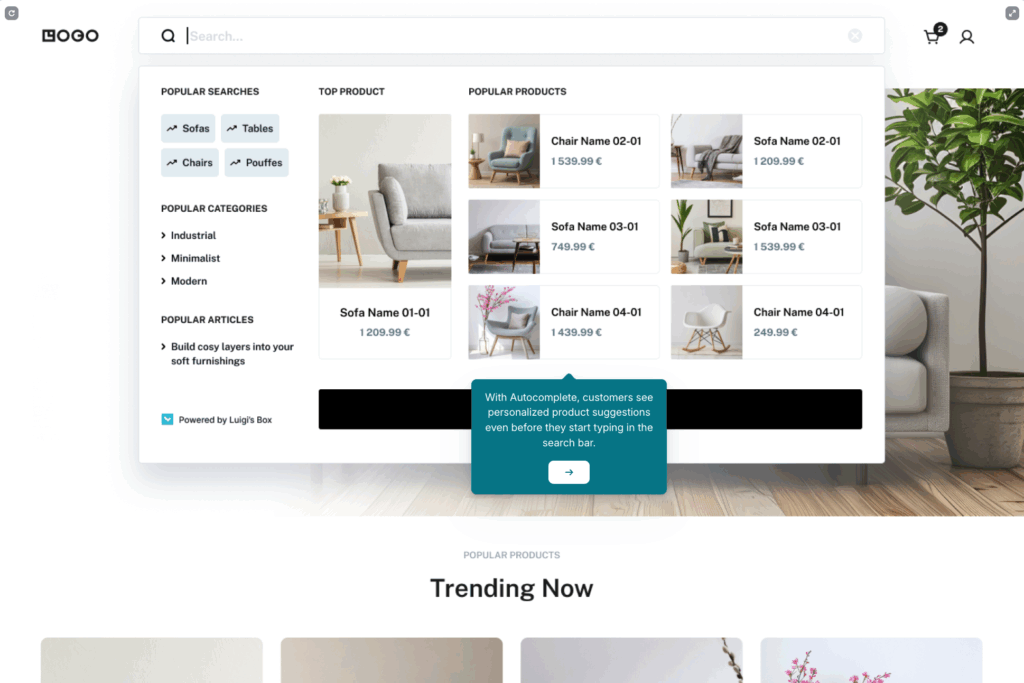
What can AI e-commerce do?
Just as Apple/Google/Klarna pay became an expectation, customers will very quickly expect online stores to know what they like, what they’ve looked at, and what they might want next.
From dynamically reordering category pages to tailoring product recommendations, search results, and on-site messages in real time, AI allows every shopper to see a version of your store designed just for them. The data is already there, browsing history, buying behaviour, even subtle signals like time of day or device type. AI just puts it to work, instantly.
1. Hyper-relevant category pages
AI reorders your product listings based on each shopper’s real-time interests.
Instead of static grids, platforms like Constructor and Hullabalook use clickstream data to re-rank products for every user session. That means a customer who just browsed running shoes will see activewear first next time they open the “New In” page, without any manual merchandising required.
Increased product discovery, lower bounce rates, and up to 20% more revenue per session.
2. Real-time product recommendations
AI learns what customers want before they do.
Engines like Amazon Personalize, Nosto, and Klevu use behavioural, transactional, and contextual data to instantly serve personalised cross-sells, upsells, and bundles. Think: “Frequently bought together” that actually feels helpful.
AI-driven product suggestions can account for up to 40% of total ecommerce revenue on high-performing sites.
3. Dynamic content, promotions & offers
AI helps you show the right message to the right customer at the right moment.
Platforms like Dynamic Yield and OptiMonk personalise everything from homepage banners and promo bars to exit-intent pop-ups, using triggers like browsing behaviour, cart value, geolocation, and even live weather.
Personalised content drives higher CTR, more add-to-carts, and fewer abandonments, especially for mobile shoppers.
4. AI-powered search & merchandising (“searchandising”)
Smart search that understands people, not just keywords.
AI-enhanced search tools like Klevu, Luigi’s Box, and Fast Simon combine NLP (natural language processing), typo correction, and revenue-optimised ranking. That means even vague or misspelt queries lead to great results, tailored to intent and profit margins.
AI search increases search-to-cart conversions by up to 50%, while reducing “no result” pages and boosting high-margin products.
5. Predictive segmentation & lifetime value targeting
AI segments your audience by behaviour and future value automatically.
Platforms like Bloomreach and Adobe Sensei analyse customer data to spot churn risk, predict purchase intent, and calculate potential LTV. This lets you trigger perfectly timed offers, loyalty nudges, or win-back emails, without over-discounting or blasting the whole list.
Predictive AI boosts ROI by helping you target smarter, spend less, and build deeper loyalty.
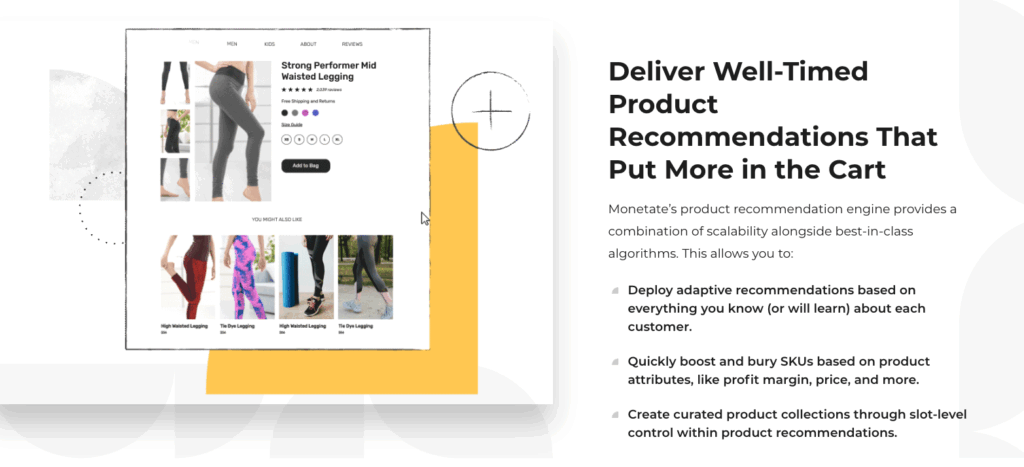
Our top 10 AI e-commerce tools (2025)
AI startups right now are a bit like an all-you-can-eat buffet. There’s a lot on the table, some of it’s incredible… and some of it feels suspiciously like it’s been reheated from last week. (Yes, I’m looking at you, crypto-startup-turned-AI-guru.)
With so many “personalisation engines” popping up, it’s easy to get caught up by jargon and demo reels. But choosing the right AI tool isn’t about chasing trends; it should solve your real business problems.
The right AI platform can make a measurable difference. Below, we’ve pulled together 10 of the best AI tools for e-commerce in 2025 based on capability, usability, and fit for different business types.
1. Monetate
Best for: Mid-sized to enterprise retailers looking to personalise at scale.
Why it’s great: Monetate offers powerful real-time personalisation across product recommendations, banners, and even full category pages. It’s designed for teams that want to test, iterate, and optimise without depending on developers for every tweak.
Consider this if: You want to personalise across multiple touchpoints with enterprise-grade A/B testing baked in.
Watch out for: The platform is powerful, but it’s not the cheapest. Best suited for businesses with the traffic to make it count.
2. Constructor
Best for: Large catalogues, marketplaces, and search-heavy sites.
Why it’s great: Built with product discovery in mind, Constructor uses clickstream data to re-rank search results and PLPs (product listing pages) in real time. It’s particularly strong at surfacing the right product faster and optimising for revenue, not just relevance.
Consider this if: You need smarter search and merchandising at serious scale.
Watch out for: You’ll need dev resources. This is not a plug-and-play solution… but it’s worth it for high SKU, high revenue stores.
Best for: Shopify and Magento users who want quick wins.
3. Nosto
Why it’s great: Nosto combines product recommendations, content personalisation, segmentation, and pop-ups in one clean package. It’s intuitive, flexible, and works straight out of the box for most ecommerce teams.
Consider this if: You want fast, reliable personalisation without overcomplicating your stack.
Watch out for: While Nosto covers a lot, it’s not as deep in search or merchandising as some others on this list. Closer to a jack of all trades than a specialist.
4. Dynamic Yield
Best for: Retailers who love testing and refining customer journeys.
Why it’s great: Dynamic Yield goes beyond recs and pop-ups—it’s a full personalisation engine with a strong experimentation toolkit. Great for teams focused on CRO, multi-channel campaigns, and long-term LTV.
Consider this if: You have in-house marketing or product teams that want complete control over testing and targeting.
Watch out for: It’s a powerful system, but expect enterprise pricing and a more involved setup process.
5. Klevu
Best for: Brands where on-site search is underperforming.
Why it’s great: Klevu enhances ecommerce search with natural language processing, typo tolerance, and personalised product rankings. It also supports product recs and dynamic filters—particularly handy on Shopify and headless builds.
Consider this if: Your shoppers aren’t finding what they’re looking for fast enough.
Watch out for: Recs are solid, but not as robust as standalone engines like Constructor.
6. Amazon Personalize
Best for: Developers and data-savvy teams.
Why it’s great: This is the same machine learning engine Amazon uses for its own store. You can build fully custom recommendations, segmentations, and ranking models with maximum flexibility.
Consider this if: You want deep control over personalisation logic and have the internal resources to handle it.
Watch out for: There’s no drag-and-drop interface here; it’s API-driven and designed for custom builds.
https://aws.amazon.com/personalize
7. Adobe Commerce (Sensei)
Best for: Magento stores already locked in the Adobe ecosystem.
Why it’s great: Sensei powers Live Search and AI merchandising directly inside Adobe Commerce. You get native access to product recommendations, customer segmentation, and analytics without third-party plugins.
Consider this if: You’re already using Adobe tools and want a native AI solution with minimal integration friction.
Watch out for: Locked into Adobe’s roadmap, less flexibility, function & support compared to modular tools.
https://business.adobe.com/products/commerce/commerce-personalization.html
8. OptiMonk
Best for: Marketers focused on on-site engagement and conversions.
Why it’s great: OptiMonk uses behavioural data to serve pop-ups, surveys, product suggestions, and messages tailored to cart value, scroll depth, exit intent and more. A strong tool for growing brands focused on CRO.
Consider this if: You want to lift conversions with smarter pop-ups and nudges, not just discount codes.
Watch out for: It’s an overlay-focused tool, if you’re after full-page or search personalisation, you’ll need to pair it with something else.
9. Luigi’s Box
Best for: WooCommerce & Shopify stores or multilingual markets.
Why it’s great: This lightweight platform offers AI-powered site search, autocomplete, and product recommendations with an emphasis on language support and typo tolerance.
Consider this if: You want smarter search and a user-friendly setup without heavy tech lift.
Watch out for: Not as feature-rich as larger platforms, but perfect for growing stores.
10. Fast Simon
Best for: Fashion, beauty and visual-heavy D2C brands.
Why it’s great: With visual AI, Fast Simon helps shoppers “complete the look,” find similar styles, and get relevant recs based on image data. Also includes smart collections, bundles, and merchandising tools.
Consider this if: You want to make product discovery feel curated especially in visual-first categories.
Watch out for: Best results rely on strong product imagery and clean tags.
Which AI Tool Is Right for You?
There’s no universal winner, it depends on what problem you’re trying to solve first:
- Need to fix your search UX? Try Klevu or Luigi’s Box.
- Want to increase AOV fast? Start with Nosto or Dynamic Yield.
- Have complex inventory or a large team? Look at Constructor or Monetate.
- Already deep (trapped) in the Adobe stack? Sensei fits naturally.
- Want something more lightweight to boost conversions today? OptiMonk is an easy win.
Need help choosing or implementing the right platform? Get in touch, we’ll help you cut through the noise.
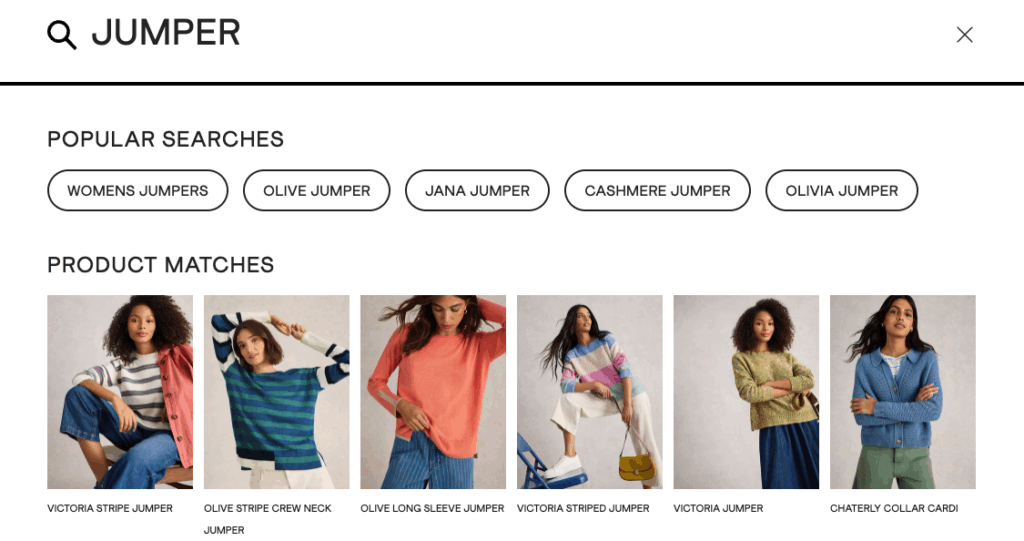
How to use e-commerce AI on your store
AI isn’t a magic button. You cant just add an app to your store and expect revenue. You need to match the right solution to a real-world challenge, setting it up properly, and giving it the data (and time) it needs to work.
Step 1: Start with one clear goal
AI tools are built to optimise specific outcomes. So don’t try to personalise everything from day one.
Instead, ask:
“What’s the single KPI we want to improve first?”
- Poor product discovery? Optimise search or PLP ranking.
- High bounce rate? Try personalised content or smart overlays.
- Low AOV? Use upsell/cross-sell recommendation engines.
- Too many abandoned carts? Test dynamic pop-ups or pricing incentives.
Treat AI like you would paid ads, define the outcome first, then the issue, then the tool that fixes that.
Step 2: Audit your data
AI runs on data, and messy or incomplete data is the fastest way to tank performance. You’d be surpised how many 7 figure stores I’ve seen with inaccurate tracking…
Check the basics:
- Are your product tags (e.g. size, colour, category) complete and consistent?
- Is your event tracking clean & accurate? (Add-to-cart, viewed product, etc.)
- Can your platform track behaviour across sessions, devices, and logins?
You don’t need “perfect” data to get started, but the cleaner it is, the smarter your AI will be.
Step 3: Choose a tool that matches your stack & skillset
Not every ecommerce business needs an enterprise platform. Here’s a quick match guide:
- Solo marketers or small teams: Tools like Nosto, OptiMonk, or Klevu work straight out of the box.
- Mid-sized teams with developers or agencies: Dynamic Yield, Constructor, or Fast Simon offer more control and depth.
- Larger brands or data-rich businesses: Monetate, Adobe Sensei, or Amazon Personalize give you full flexibility, if you’ve got the team to support it.
Reminder: It’s better to implement one well-fitted tool than half-integrate multiple bloated platforms.
Step 4: Implement and test on a controlled segment
Roll out your AI solution to a test group first, either a % of traffic or a specific audience segment. Then compare against a control group (A/B testing or holdout group) to measure real impact.
Watch metrics like:
- Conversion rate
- Average order value
- Time on site
- Product discovery rate (e.g. % of users interacting with search or recs)
Don’t judge performance too early. Most AI models take 2–4 weeks to learn patterns and optimise effectively.
Step 5: Iterate, expand, optimise
If your initial test performs well, scale it up:
- Expand to more segments, channels (email, app, on-site), or device types.
- Use insights from winning segments to build stronger audience personas.
- Layer in more AI tools as needed (e.g. once search is optimised, look at pricing or content).
If it underperforms? Dig into the data:
- Was the input data clean?
- Was the sample size large enough?
- Were the KPIs realistic?
- Did the model have enough time to learn?
Then test again, with better inputs or a more relevant tool.
Step 6: Compliance, privacy & human-focused
Modern AI tools are powerful, but personalisation without permission is a fast way to lose trust.
Make sure your platform supports:
- GDPR/CCPA compliance
- Cookie opt-ins and tracking controls
- Anonymous or consent-mode personalisation
And remember: AI should make your store feel more helpful, not more invasive.
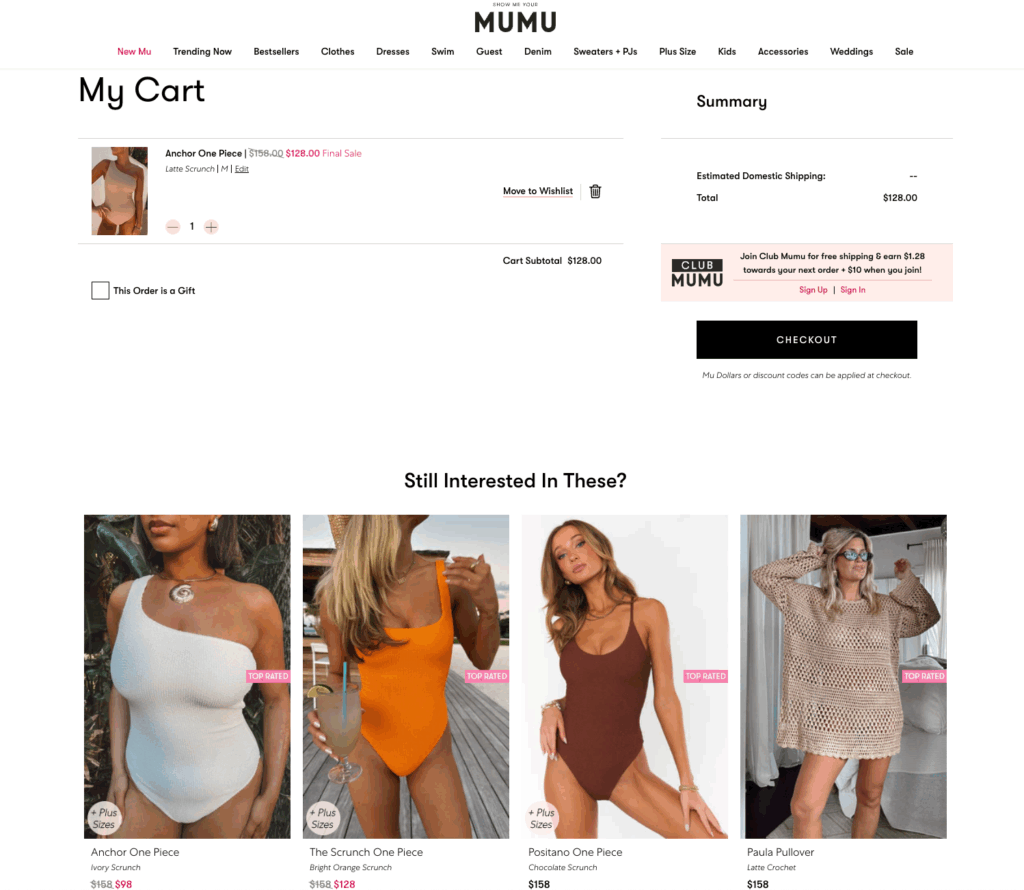
What’s next? 5 big AI trends for e-commerce (2025–2030)
The AI bubble hasn’t popped, and it’s not about to. The tech is still picking up speed, and if you’re not adapting, you could end up the 2030 equivalent of a Yellow Pages die-hard. Remember them? Thought the internet wouldn’t catch on… wonder how that worked out.
Smart ecommerce brands are already using AI to serve customers faster, surface better products, and stay relevant. The next five years will take things even further. Here’s what’s on the horizon and what you can start doing today.
1. Generative shopping companions
AI won’t just recommend things based on clicks. It’ll start behaving like a personal shopper that knows your size, style, budget and even your mood on a Monday morning. Expect smart agents that help customers build outfits, plan gifts or reorder favourites without needing to search at all.
What to do now
Start collecting real preference data. Ask questions. Build quizzes. Let users save their sizes, style filters or favourite colours. The more you know now, the more useful your AI assistant can become later.
2. Visual and voice search
Typing in “white trainers size 9” is fine, but it won’t last. More shoppers are already using their voice or photos to find products. Whether it’s “find a birthday gift under £50” or a screenshot of something they saw on Instagram, AI will do the heavy lifting.
What to do now
Use proper alt text and make sure every product is tagged with things like colour, material and fit. Add structured data to your product pages. And if you sell anything remotely eco-conscious or ethical, label it clearly. These are the signals search tools are starting to prioritise.
3. On-Device and federated learning
Privacy laws aren’t going backwards. The future of personalisation will rely on models that process data on the shopper’s device, not your servers. That means faster experiences for users and fewer compliance headaches for you.
What to do now
Choose tools that support privacy-first features like federated learning or anonymous personalisation. Make sure your tracking is consent-friendly. And evaluate how to future-proof your data handling before regulations force your hand.
4. Real-time pricing and smarter offers
We’re moving into a world where pricing can change based on real-time signals like stock levels, customer loyalty or even time of day. Done right, this can boost conversions and protect margin without feeling pushy or manipulative.
What to do now
Centralise your pricing logic so you can test dynamic rules. Try offering early access to repeat customers, or discounting overstock to high-intent segments. You don’t need AI to get started. Just a plan and the right triggers.
5. Values-based personalisation
People want to buy from brands that align with what they care about. AI will start factoring in everything from carbon footprint to inclusive sizing when recommending products. Relevance will mean more than just colour or price, it’ll mean values.
What to do now
Audit your product catalogue. Where you can, add tags for sustainability, ethical sourcing, recycled materials or size inclusivity. This is the kind of data modern shoppers notice, and it will shape personalisation logic sooner than you think.
Final thoughts: AI, AI, AI… yes, but there’s a reason for it
In almost every industry, there’s a lot of noise about AI right now — but arguably nowhere more than in marketing. (We do love shouting about things.)
It’s easy to tune it out.
But in e-commerce? AI isn’t just a buzzword. It marks the start of a shift. A shift in what platforms can do, sure… but more importantly, in what customers expect.
The brands that learn to use it properly aren’t just adding fancy tools. They’re building stores that feel sharper, faster, and more personal. The kind of experiences that customers don’t just tolerate, but actually enjoy.
Let’s be clear: AI won’t fix your problems. It’s not magic. It’s a tool.
Lean on it too hard, try to replace human creativity, or automate everything, you’ll end up with something robotic, cold and… bleak.
But if you’re smart about how you use it? If you keep your voice, your vision, and your customers at the centre?
That’s where the good stuff happens.
Helping people find the right product.
Showing the right offer at the right time.
Keeping loyal customers coming back.
And yes — doing all of that with a little less effort.
AI helps you be a little lazy. But it’s not I Robot… yet.
Ignore the hype. Focus on the parts that actually solve problems. Start small, stay human, and scale what works.
And if you want someone to cut through the waffle and help you make the right moves? You know where we are.
More resources
Real use cases
Using e-commerce in AI isn’t limited to ready-made tools, this video showcases some unique use cases from store owners:
AI video, but actually useful
Ever wish your homepage video adapted to what people really cared about? AI-driven product videos now change content based on live shopper actions—so everyone gets a highlight reel that fits. The result: more discovery, fewer bounces, and promotions that feel tailored:
https://www.gotolstoy.com/post/product-video-ai
How to use AI for A/B testing
This article explores how generative and predictive AI technologies can be leveraged to enhance experimentation:
https://www.kameleoon.com/ai-ab-testing
Use AI to create your own AI apps for your store
Some of the latest tools you can use to solve specific problems on your store:


